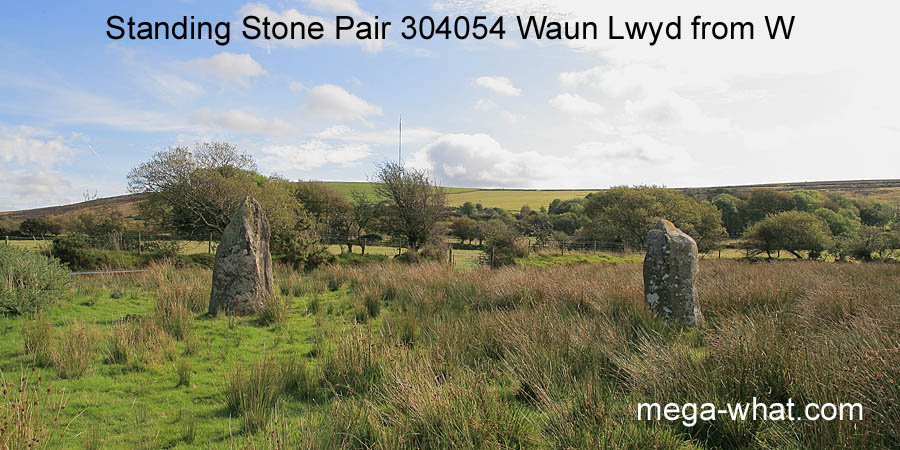 Waun Lwyd Standing Stone Pair is south of the Preseli Hills in Pembrokeshire, in the headwaters of the Cleddau, between Foel Drygarn and Foel Drych -
about 3.5km south-west of Crymych. Ask at the farm for permission to view them.
Waun Lwyd Standing Stone Pair is south of the Preseli Hills in Pembrokeshire, in the headwaters of the Cleddau, between Foel Drygarn and Foel Drych -
about 3.5km south-west of Crymych. Ask at the farm for permission to view them.
The two stones are both a little over 2m high and about 8m apart. The axis of the pair, approx 25°, is beyond the lunar limits in both directions.
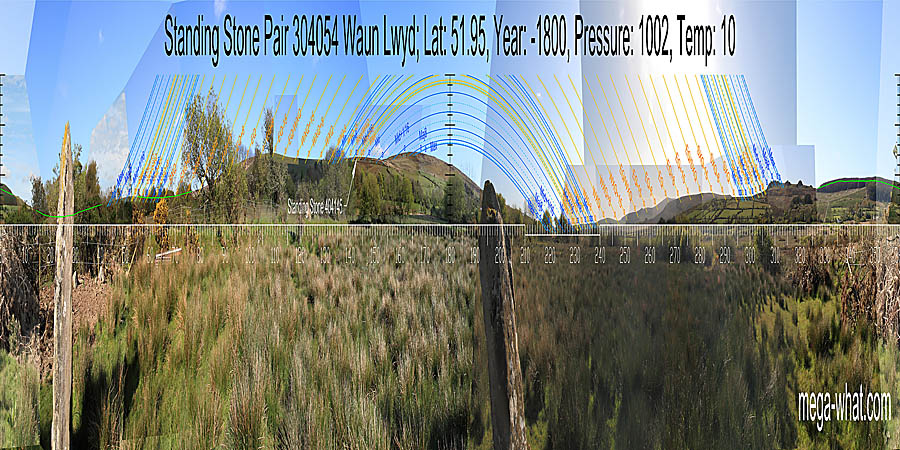 South is on a slope, at the right hand end of a hilltop.[Pic].
South is on a slope, at the right hand end of a hilltop.[Pic].
North is at the right hand end of a hilltop and maybe on the slope [Pic].
Green lines approximate hidden horizon segments.
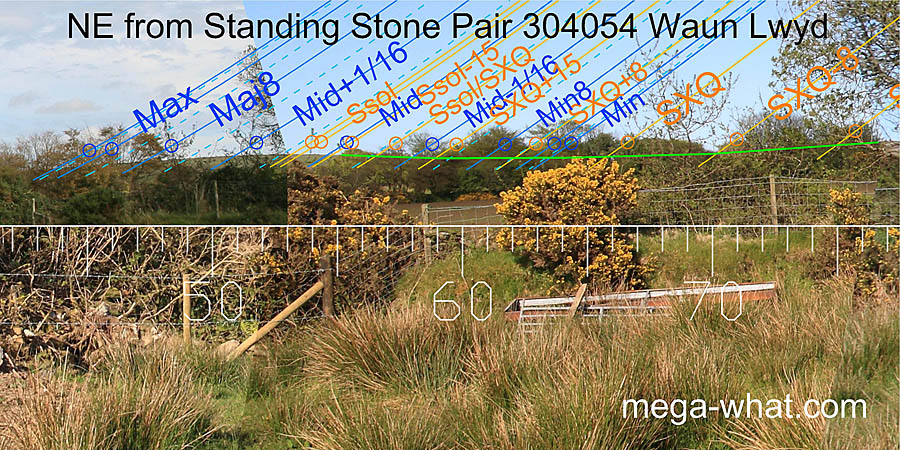 North-eastwards the view towards the head of the valley and much of the eastern rising ground is almost completely obscured by vegetation. [View NE pair axis]
North-eastwards the view towards the head of the valley and much of the eastern rising ground is almost completely obscured by vegetation. [View NE pair axis]
 South of the equinox, its half-month bracket would seem to be at a high point of the ridge, with the cross-quarter at the low point, or perhaps to one side of it.
South of the equinox, its half-month bracket would seem to be at a high point of the ridge, with the cross-quarter at the low point, or perhaps to one side of it.
 The minor end of the lunisticeLunistices are the most northerly and southerly moons of the month. The lunar equivalent of solstices - more.
range coincides with the start of the rising ground and the major end is at the top of Foel Drych.
The sixteenth on the major side of the midpoint falls at the foot of the final slope which is shallow enough to stretch the most southerly moon rises over many degrees of azimuth.
Note that the hump at the base of the slope is not a natural feature but the spoil heap from a small mine.
The minor end of the lunisticeLunistices are the most northerly and southerly moons of the month. The lunar equivalent of solstices - more.
range coincides with the start of the rising ground and the major end is at the top of Foel Drych.
The sixteenth on the major side of the midpoint falls at the foot of the final slope which is shallow enough to stretch the most southerly moon rises over many degrees of azimuth.
Note that the hump at the base of the slope is not a natural feature but the spoil heap from a small mine.
On this ridge, the period during which the solstitial full-moon may be seen setting in the north-west is accurately delimited [Enlargement] by Standing Stone 404145 which is about 750m away as the crow flies.
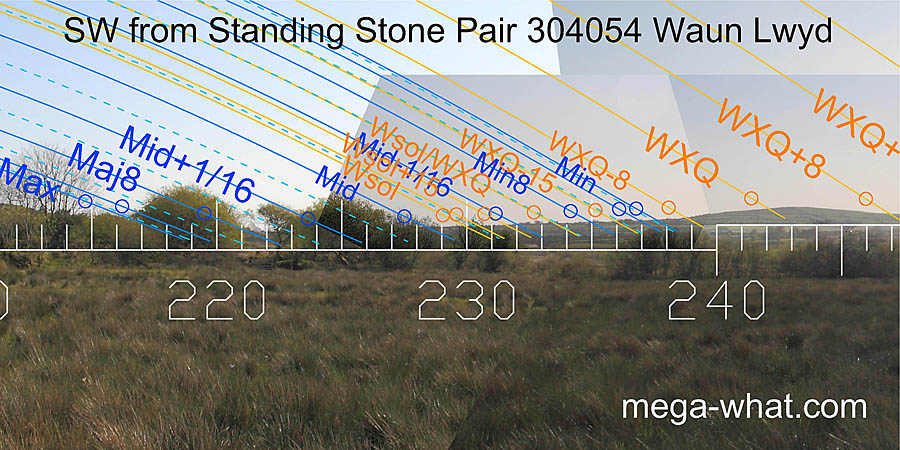 Trees obscure the view south-westwards down the valley but the lunisticeLunistices are the most northerly and southerly moons of the month. The lunar equivalent of solstices - more.
range must start near the bottom, from where it runs up a fairly smooth slope.
The sequence terminates at the basal step of a hill with the southern quarter-month bracket of the cross-quarter.
Its northern bracket is at the other basal step with the cross-quarter itself just failing to make the hilltop. [View SW pair axis]
Trees obscure the view south-westwards down the valley but the lunisticeLunistices are the most northerly and southerly moons of the month. The lunar equivalent of solstices - more.
range must start near the bottom, from where it runs up a fairly smooth slope.
The sequence terminates at the basal step of a hill with the southern quarter-month bracket of the cross-quarter.
Its northern bracket is at the other basal step with the cross-quarter itself just failing to make the hilltop. [View SW pair axis]
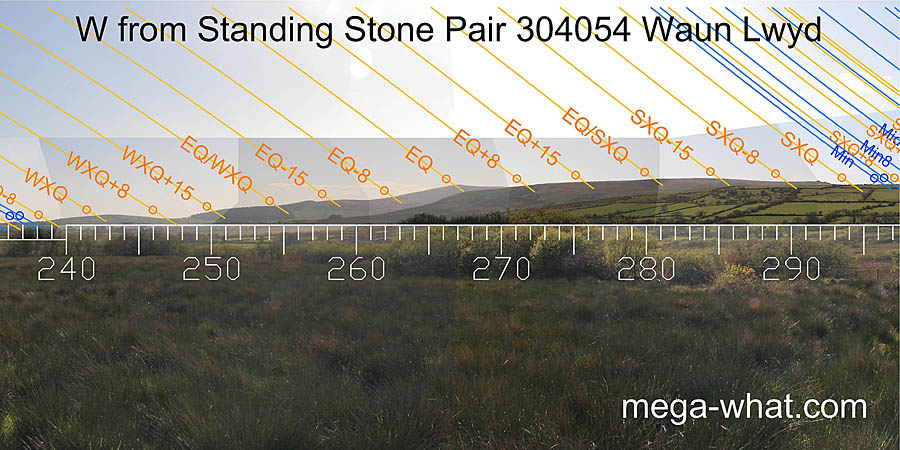 Foel Cwmcerwyn's summit has the equinox on it and there are a couple of good marks on its southern slope.
Foel Cwmcerwyn's summit has the equinox on it and there are a couple of good marks on its southern slope.
Beyond that, a long ridge has an eqinoctial quarter-month bracket at its southern end and another for the cross-quarter in a dip at the northern one. Summer cross-quarters themselves are at the intersect with a nearer ridge.
 The north-western lunisticeLunistices are the most northerly and southerly moons of the month. The lunar equivalent of solstices - more.
range runs up this nearer ridge to finish over the rocks of Carnmenyn.
The north-western lunisticeLunistices are the most northerly and southerly moons of the month. The lunar equivalent of solstices - more.
range runs up this nearer ridge to finish over the rocks of Carnmenyn.
On the way, there are useful marks at changes in the slope for the half-month north of the cross-quarter as well as the solstice and its brackets.
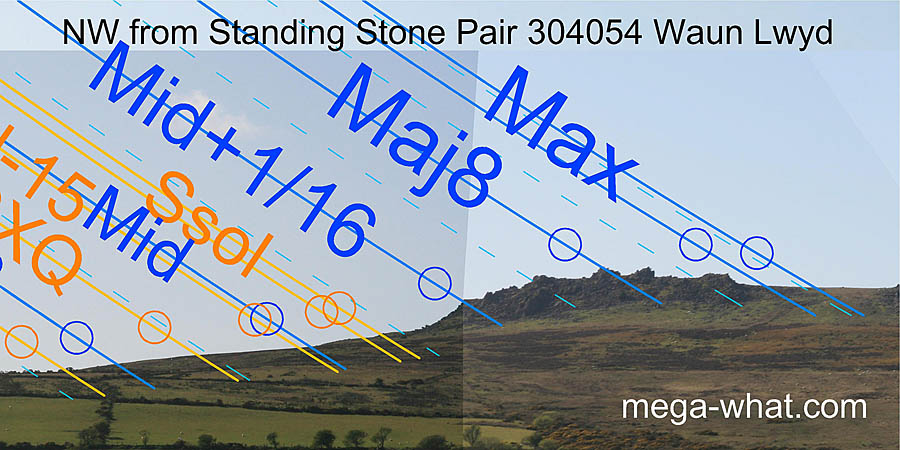 The crags of Carnmenyn are about 1.9Km away and so moving from one stone of the pair to the other would shift the lunar disc against the horizon by about 1/2 diameter.
Survey was from mid-way between them. Interestingly:
"There are hints of other stones in the vicinity extending the alignment, but these are problematic" (Coflein).
The crags of Carnmenyn are about 1.9Km away and so moving from one stone of the pair to the other would shift the lunar disc against the horizon by about 1/2 diameter.
Survey was from mid-way between them. Interestingly:
"There are hints of other stones in the vicinity extending the alignment, but these are problematic" (Coflein).
- Gors Fawr Standing Stone Pair is 2.8km to the south-west and close to Gors Fawr Stone Circle, the only remaining circle in this area.
- Rhos Fach Standing Stone Pair is 2.5km to the west-south-west.
- Cwm Garw Standing Stone Pair is 4km to the west.
References
- National Monuments Record of Wales: Coflein database - site details.
- FIGGIS, N.P. 2001 Prehistoric Preseli a field guide. Machynlleth: Atelier Productions. p97, no.94.
